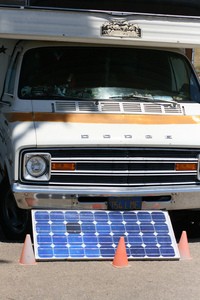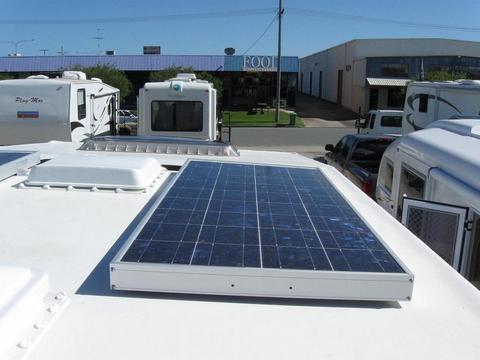 When RVers go boondocking, they’re living without the benefit of utilities.
When RVers go boondocking, they’re living without the benefit of utilities.
How to come up with enough electrical power to function daily is up to each individual RVer. Running an extension cord across the desert to the nearest power pole is definitely not an option.
Many opt for generators, though their noise pollution (and the fuel they require) can be annoying as well as a costly source of electricity.
A cleaner, quieter option is a solar-powered RV system that will maintain the charge on your batteries without any more fuel than the sunlight.
Solar panels provide 12-volt DC power to charge a set of batteries.
Now, see how RV solar panels work, plus how to install them in your own RV…
How RV Solar Panels Work
By installing extra batteries in your RV, you can store additional power to handle all of your electrical needs.
With the addition of an inverter (which changes 12v DC power to 110v AC power), you can continue to use all of the additional conveniences that make RVing so much fun — like large TVs, a microwave oven, even power tools or fancy kitchen appliances.
You can run any item (or group of items) that fall within the amperage rating of your inverter.
All 12vDC electrical items can be operated directly off the bank of batteries. Your only limitations will be the quantity of batteries you choose to install and the capacity of the solar panels you pick to charge them.
Installing RV Solar Panels
Designing an RV solar system is easy. Most suppliers can help you determine which type of RV solar panel system will work best for your needs.
With a bank of 4 deep cycle batteries being recharged by 2 or 3 solar panels, you should be able to manage your electrical needs. A 2,000-watt inverter will be enough to run any microwave and pretty much anything else (except for an air conditioner).
Do remember that anything with a heating element (such as an electric coffee pot, hair dryer, or especially a portable electric heater) will consume your available 110-volt AC very quickly. Conservation is mandatory, in order to avoid running out of juice at just the wrong time!
The whole idea of staying on BLM (Bureau of Land Management) land is to kick back and relax. A solar-powered electrical system will take the annoyance and hassle out of making electricity. It’s definitely a step in the right direction.
See how to install RV solar panels:
- RV Solar Panel Installation Guide
- Installing RV Solar Panels
- Types Of Solar Panel Mounts
- Doing An RV Solar Panel Installation
- How To Install RV Solar Panels
- Solar RV Battery Charging Kits
- Drilling & Mounting RV Solar Panels
- Installing RV Solar Panels On An RV
Optional Wind Generator
Of course, there is one more thing you can do to make sure you’re not caught with your volts down. A small wind generator mounted on a pole attached to the ladder on the rear of your RV will ensure that on cloudy days you’ll still be able to recharge and maintain your battery bank.
Here’s how it looks:
RVs Go Green
With a combination solar and wind electrical system on your RV, you’ll be part of the cutting edge green movement helping to conserve our fossil fuels.
Plus you’ll pass the good neighbor test, too!
For alternative power no matter where you are — at home or on the road — consider the Duracell Powersource 1800:
For more information about this type of backup power while you’re RVing, check out RV Backup.




